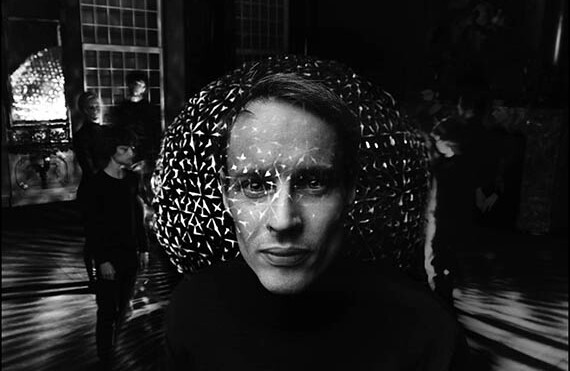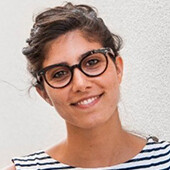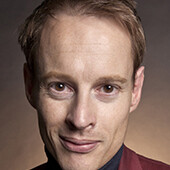Imagine for a second a dark road lined with trees, glowing in the night as jellyfish do. Imagine cities without streetlights, but rather with rows of beautiful, energy-efficient, glowing trees. Imagine humans fighting pollution with giant smog vacuum cleaners. Imagine electric cars recharging while driving. And now—stop imagining. Daan Roosegaarde is the 35-year-old Dutch artist behind these "crazy" ideas. He is an innovator, but he does not make apps and he is not based in Silicon Valley. He designs energy-neutral and incredibly beautiful landscapes. He calls it "techno poetry."
IRENE PEDRUELO: In a moment where everyone seems to be glued to screens and detached from the physical experience, you are advocating for a return to the landscape, to the physical experience, and nature. How does an artist end up being interested in roads, urbanism, and energy-efficiency?
DAAN ROOSEGAARDE: I've always had this fascination as an artist, as an inventor, as a designer, and as an architect to not operate in the white cubicle of a museum, but indeed to go public. I've always believed in this notion of making spaces which are open, engaging, and which create some kind of interaction among people and the environment. I fell in love with places before falling in love with girls, so the notion of making places as a platform for innovation gets me excited, and it's in the DNA of all the projects we have done. For instance with the Dune—the artwork of light—we started by placing it in pedestrian tunnels, before it went to Tate Modern. I really get enthusiastic about that—I don't know why. Maybe [it] is my little mission so to speak.
IRENE PEDRUELO: If someone looks at your portfolio and the projects your studio has led, they will be surprised by its diversity. We can find a project to create smog-free urban skies, an interactive dance-floor that generates electricity, a path decorated with fibers that "brighten according to the sounds and motion of passing visitors," and finally the smart highways, "sustainable roads of today," as you have defined them.
DAAN ROOSEGAARDE: All those ideas have something in common. On the one hand, we are making landscapes pragmatic, neutral, and self-sufficient; and on the other hand, we are making something people feel connected to, maybe even in an emotional way.
IRENE PEDRUELO: One of your most ambitious endeavors is to make roads—not cars—smarter and more sustainable. Altogether, your studio has come up with 20 revolutionary ideas that will change the way we think about roads. For now we know about a few, like the luminescent roads/glowing highway. Where does this idea of Smart Highway come from?
DAAN ROOSEGAARDE: After building a sustainable dance floor, which generates electricity when you dance on it, the studio started experimenting with the idea of the Smart Highway.
IRENE PEDRUELO: It must be more complicated than that. Where does the idea of using glowing paint to mark roads come from? Nature?
DAAN ROOSEGAARDE: I don't know. It's a fuzzy process. I make things, but making also makes me. I go diving, I see jellyfish at night deep in the water emitting light, then I go to the Netherlands and I see governments in Europe shutting down streetlights to save money. Somewhere in between I make the link, and I think: If the jellyfish can do it without government and without solar panels, why can't we? As human beings we are supposed to be more evolved!
IRENE PEDRUELO: Are you saying that the solution to many things, in this case road inefficiency, may be just there . . . in nature?
DAAN ROOSEGAARDE: Marshall McLuhan said that "There are no passengers on spaceship Earth. We are all crew." This notion of biomimicry talks about what we learn from the world around us. You look around, you get inspired, and you try to bring that to everyday life. When I look at my life, it is still very crude: I took a plane from Tokyo that used a tremendous amount of fuel. What I can do is come up with proposals that can make it a bit more sensitive, or more natural in a way. And I don't care if this is the Tate Modern, a discothèque, or an awful road in the suburbs.
IRENE PEDRUELO: How did you know that roads could become jellyfish and glow at night?
DAAN ROOSEGAARDE: I have lots of ideas about the future of highways, but I have no idea how to build them. I am a voluntary pusher of my imagination. And when I can imagine something, I know I can build it. It's just a question of getting the right team, getting the focus, and the momentum; and then pushing it and not letting it go until you have it. There are 5,000 reasons why Smart Highway could have never come to life, and it is my job to find the reasons why it should be realized. That way you operate more like an architect, fighting for his own fantasy.
IRENE PEDRUELO: It has been almost a year since you launched a glowing/luminescent highway. It's an unusual venture, because it is a joint venture between your studio and a construction company that was facing some challenges and a shrinking market, and therefore looking for new market opportunities.
DAAN ROOSEGAARDE: The building industry in Europe was in crisis. China can build one year cheaper and one hour faster, so the road manufacturer was looking to add value to what it does. It was not marketing. This was a CEO who realized that they had to shift their model, and what they were selling in five to 10 years. The economic situation just speeded up that process of innovation.
IRENE PEDRUELO: Do you both represent opposite ideas, you being the out-of-the box thinker and governments being bureaucratic machines?
DAAN ROOSEGAARDE: It is my job to show what a new world can look like and to open up the conversation. We can complain about governments, but the fun part is that, for instance, when we launched glowing lines, the Dutch minister of infrastructure, Melanie Schultz Haegen, came and walked around for four hours with a smile on her face. Two days later, before TV cameras, she announced she wanted to implement glowing lines on Afsluitdijk, a very famous 32-km causeway in the Netherlands, which protects our land from the sea, but also attracts a lot of tourism and has an iconic value. I believe that we can wait, or we can propose things, make them tactile, and create an experience.
IRENE PEDRUELO: How do you convince governments that innovation is not an extracurricular activity but a must? The kind of innovation that you propose—based on mimicking nature—is very different from the kind coming from places like Silicon Valley, which is more widely accepted.
DAAN ROOSEGAARDE: Shutting down streetlights to save money, which is what governments all over the world are doing right now, is doing less, not more. The current crisis forces us to be creative. Good governments should allow experiments on the future of mobility, the future of health, and the future of energy to happen. They should encourage them and recognize that they don't know what the future will look like, but that they can facilitate it. They are losing their power, it scares the hell out of them, and maybe that is good.
IRENE PEDRUELO: Still, convincing policymakers must be more difficult than telling them that they must be creative and open-minded.
DAAN ROOSEGAARDE: With every type of innovation, with every project that we've done, there are three ungrateful phases you have to go through. Phase one: when you present an idea and people say: "It cannot be done, it is not possible." Then you spend a lot of energy and money showing them it is possible. Phase two, when people say: "Okay, it's possible but it is not allowed." There is an actual law in the Netherlands, which we had to change, that stated that the line on the side of the road should be white [the glowing lines are green]. So we had to go through a process to change it. And the ungrateful phase three is when people ask: "Why has no one come up with this before? Why doesn't it exist yet?" Smart Highway went through these three phases in Europe, not in the United States yet. We are still in phase two of acceptance in the United States. It is not easy, but the moment you are aware of that, you can play with it. People say they want innovation, but there is this tendency for nostalgia, to be sentimental, etc.
IRENE PEDRUELO: There is also this romantic idea some people have about the past; as if it was always better than the present.
DAAN ROOSEGAARDE: True. In a way when you look at our projects, there is always something old, something new, and something borrowed. We met with the Tokyo government and they loved the glowing lines, because it reminds them of the Edo Period gardens. They could relate to it in a traditional way, but they could also relate to this energy-neutral future, because of the nuclear disasters that have happened there in the last years. When you design incorporating elements of the past and the future, people can associate it with it. That is a very intuitive factor embedded in all our designs, and also a very important argument of good design for me. Not only must it be effective, but it must also let you play with it and plug in from different levels. You can use design to seduce people to take one step forward.
IRENE PEDRUELO: You have been critical of Silicon Valley's model of innovation that you defined as "screen-based" and monopolized by a few. How can transformation come about through the efforts of many rather than some?
DAAN ROOSEGAARDE: I have a problem with screen-based innovation. Most of our social lives are happening in the virtual world, on Facebook, Twitter . . . but our physical or analog environment is sort of crashing. Governments are shutting down schools, roads, etc. Are we going to wait for Silicon Valley to design the new app again, or are we really going to engage with urban life, with the place we live in, our habitat? Shouldn't we connect these two worlds together somehow? I love to make things that do not have a download or like button.
IRENE PEDRUELO: You are a supporter of technology "jumping out" of the computer screen as a way of connecting these two worlds together. What does this mean?
DAAN ROOSEGAARDE: Technology will become our second language, our second skin. All these buzzwords like Internet of Things or augmented reality are linking those analog and virtual worlds together. For me that is where real exciting things happen. These innovations won't pop up in the Google garage any more, they will happen at the city level. Our best clients are mayors: the mayor of Beijing, mayor of Eindhoven, mayor of Stockholm . . . these are people who have a social and economic agenda and the public is their audience.
IRENE PEDRUELO: You could be considered a social innovator, someone who finds novel solutions to the world's most pressing challenges. For decades, many took as a given that if you do social good you are condemned to be poor (from an economic point of view). This view is rapidly changing and the so-called social enterprises are demonstrating that doing good and profit are not mutually exclusive.
DAAN ROOSEGAARDE: Some people are still stuck in the old hippy ideology, which was nice 30-40 years ago, but is completely useless in a time like this. I am not saying NGOs are hippy, but sometimes this pops up. I am sort of a hippy with a business plan. I believe that making things creates soft capital—new ideas, new dreams—but also hard capital. I cannot pay my experts in pizza all the time, they will leave me. The CEO of the road manufacturer is not investing so much time and money for good PR. He needs to see some kind of value popping up, a new market, a new economy. Connecting with hard capital value or economic value is very important if you want to have impact, but, yes, it's a struggle.
IRENE PEDRUELO: Many innovators opt for releasing the technology open source so other people can use it and scale up the impact of their projects. In your case, you have not unveiled the magic formula of the glowing paint yet. Wouldn't this allow making roads more efficient worldwide instead of only in specific locations your studio is working on?
DAAN ROOSEGAARDE: Right now we are not sharing the knowledge but we are sharing the ideas. I don't think is the time to open-source for how you make light-emitting paint. There will be a time for sure, but I want to spend the coming five years refining it, perfecting it, and making sure that the idea has the results I envision it to have. I am afraid that if we open-source it now, it will become decoration, something people just use because it is nice. I don't want to decorate, I want to talk to governments and I want to reform. The notion of sharing is embedded in what we do, but more in that is public, that is for everyone, and that you don't get to pay for an entry ticket; but sooner or later it will open up.
IRENE PEDRUELO: As an innovator, you are still working within an existing system, and assuming that in the future, for instance, people will still drive cars. Are you being conservative, pragmatic, or realistic?
DAAN ROOSEGAARDE: I am restraining myself in order to have impact. I could tell you a whole story right now about cars that will fly in 100 years, but who cares, you won't be able to check it. In 100 years you are going to be dead and I am going to be dead, so there is no discussion or interaction between you and me or the audience. In our projects, we focus on the coming five to 10 years; we call it MAYA—Most Advanced Yet Acceptable. I am absolutely not interested in talking about flying cars; I am interested in hacking the reality we live in now. This is not conservatism; this is a constraint I place on myself in order to make change happen. It's a choice.
IRENE PEDRUELO: We live in an increasingly data-driven society. You need data not only to convince governments, but also to convince tax-payers. How sustainable or energy efficient are your projects? Is there data available?
DAAN ROOSEGAARDE: Our goal is to be competitive with the existing systems. Glowing lines are cheaper than existing street lights. We have four big pilot projects and we are making the technology even better.
IRENE PEDRUELO: The cost of the e-priority lane—an induction priority lane that will charge your electric car while you drive—could bring an incredible revolution to roads, but critics state its cost has never been addressed.
DAAN ROOSEGAARDE: Well it depends! A pan costs 10€ ($11), but the nonstick coating didn't cost $10. The technology came from NASA. Things start high-end and expensive, but the knowledge you build up ends up in the default that you and I have every day. So the question is: More expensive compared to what? We have 20 ideas for Smart Highway, but maybe only 10 of them will influence the way we will build roads in the future. They will influence the default, and that is how innovation goes. If you think too short-term, nothing changes. You need people with vision and leaders with guts. It's innovation, so one investment has to be made.
Policy Innovations' Seven Quick Questions
Where do you see yourself in 20 years? The same but more.
What are the three main attributes of an innovator? Curiosity, ability to ignore those saying "yes but," and a great team.
What other obsessions do you have beyond urban mobility? You mean in the coming months? The future of health, future of energy, and food.
What does social innovation mean? To improve lives, and that can mean: make it smarter, more beautiful, and more social.
What do you do in your free time? I never work, I always work. Work doesn't exist for me. I like diving and I love pushing ideas ahead of my brain. I've never considered that work.
Life is about . . . a line made out of many dots and I'm one of them. Hopefully I can make the line a bit more curved.
What would you tell your younger self if you had to start over?Don't be scared, invest in your dreams.





